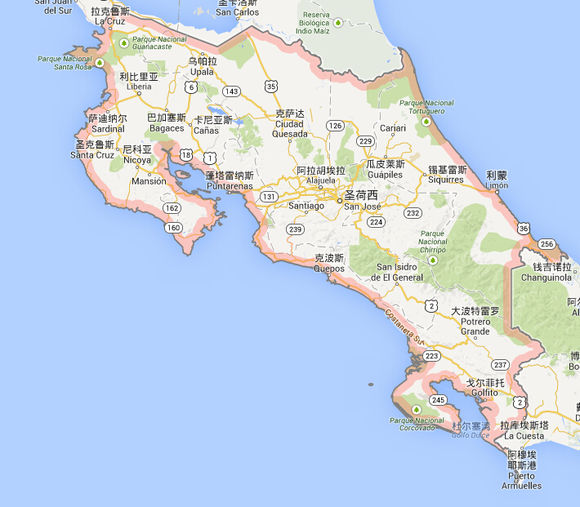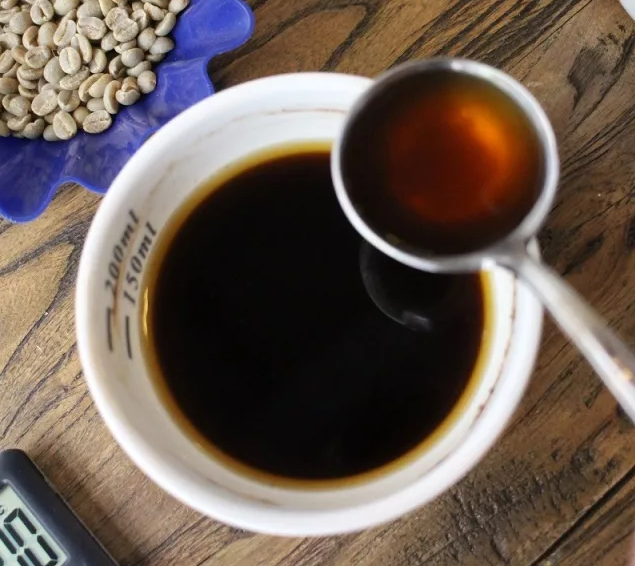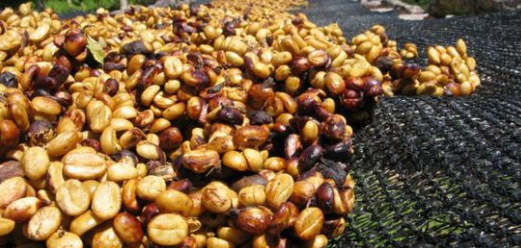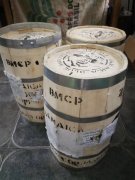Costa Rican Arabica Coffee, a big coffee country in southern Central America
Costa Rican coffee cultivation was introduced from Cuba in 1779 and exported for the first time in 1820. There are now about 32000 coffee farmers, with an average planting area of less than one hectare (10000 tons) per farmer. Costa Rica has a population of 41 billion (2006), with a coffee planting area of 82500 hectares and an annual production of 1.7 million bags (60kgs per bag). The annual domestic consumption is 380000 bags, with an average annual national consumption of 5.5kgs, which is higher than that of Japan (consumption 4kgs). At present, Taiwanese are only slightly higher than 1kg.

Costa Rica is the country where coffee was first introduced into Central America and has a long history. The coffee organization has a complete system from production to marketing. Because it is located in the Central American Isthmus, the territory is full of volcanoes and has the natural advantages of sunshine and land, and the climate is reconciled by Pacific and Atlantic currents and sea breezes at the same time, the coffee produced has the characteristics of local micro-climatic conditions. In terms of quality and quantity, Costa Rican coffee has always been recognized by the world, and has been rated as one of the world-class high-quality coffee. With many towering volcanoes up to 2000 meters above sea level, coffee berries grow slowly in fertile volcanic ash soil and cool environments at high elevations, giving birth to coffee beans with complete and rich flavor.
Costa Rica began growing coffee two hundred years ago, first on the slopes of the Poas and Barva volcanoes, today known as the Central Valley. After years of development, Costa Rica has eight main producing areas, namely: Guanacastes, West Valley, Central Valley, Turrialba, Orosi, Tres Rios, Tarrazu and Brunca.

According to ICO, Costa Rica produces about 1.6 million bags of Arabica coffee a year, which is far higher in quality and price than Central American countries such as Guatemala and Honduras.
Costa Rica can be divided into two seasons each year. The dry season is from December to April, when coffee is harvested, while the rainy season is from May to November. In recent years, micro-processing plants have been set up one after another, and since the water consumption is only 5% of that of traditional washing plants, and does not require huge sinks and exposure fields, the investment required is relatively small. The "honey-treated coffee" with low acidity, high complexity and strong sweetness has become the target of competition in the coffee industry in recent years, and the outstanding ones have greatly enhanced the international popularity of the estates.
Shumawa Manor, Costa Rica, is a very young manor; Francisco Mena, who was originally engaged in the coffee trade, bought the land and retained most of the original forests, only a small part of it was developed as a coffee growing area to maintain the natural ecological balance of the estate.
Shumawa Manor is about 1670-1790 meters above sea level. In the western valley, another well-known producing area in Costa Rica, the poor temperature, coupled with fertile soil, is very suitable for coffee cultivation.
The landowner Francisco Mena introduced a high-quality variety in the top 13 of the Super Cup, the bourbon mutant, Vera Saatchi (villa sarchi). This is a rare variety bred through the cross of red bourbon tree species. Strong wind resistance, preference for high altitude environment, excellent acidity and a variety of fruit aromas, high sweetness, bright and delicate citrus acidity and low raisin and nut aromas, high complexity and full balance.
Most of the manor is left to the forest to maintain the natural environment. In the manor arrangement, also took a lot of thought, for broken wood, rotten wood, weeds and so on do not use the traditional way of burning, but the wood is broken into pieces, and mixed with organic fertilizer, used as fertilizer on the farm.

Honey treatment method
Honey treatment, called HoneyProcess or Miel Process, is used in coffee gardens in Costa Rica (Costa Rica), Panama (Panama) and Guatemala (Guatemala), which is called Honey Coffee. The so-called honey treatment refers to the process of making raw beans with mucous membrane for sun-drying. After the outer pulp of the coffee bean is removed, there will be a layer of sticky jelly. The traditional washing method washes it away with clean water, but this direct drying method has been born because of the limitations of water resources in some high-altitude areas.
Juxtaposed with the two traditional treatment methods, water washing and sun treatment, honey treatment has become a unique method in coffee treatment. The taste difference between honey treatment and water washing treatment: higher sweetness, higher sugar content and higher alcohol thickness (under the premise of the same baking degree)
Honey treatment keeps the coffee clean after washing, and although the brightness of the coffee decreases, it increases the sweetness and caramel taste. According to the different degree of honey treatment, honey-treated coffee can be divided into yellow honey treatment, red honey treatment and black honey treatment.
According to NordicApproch, Seattle Coffee and Origin Coffee, the raw bean companies run by the big shot Tim, it can be summed up:
Yellow honey: about 40% of the pectin is removed; the drying method requires the most direct heat absorption, receives the most light drying, and lasts for about 8 days to reach a stable water content.
Red honey: about 25% of the pectin is removed; it takes longer to dry than yellow honey, and reduces direct exposure to sunlight, even in shading sheds, lasting about 12 days.
Black honey: retain close to 80% pectin; dry for the longest time, lasting at least 2 weeks, with a cover to avoid too strong sunlight, prevent drying too fast, and make sugar conversion more fully.
The advantage of honey treatment is that it can best preserve the original sweet flavor of ripe coffee, giving the coffee a light black sugar flavor and drupe flavor, while the berry flavor also supports the basic aroma of red wine, which is considered to be a very elegant product.
The biggest difference between honey treatment and Brazilian semi-washing is that the former does not drip water, because be sure to choose flawless red fruit, pectin is sweet. The honey-treated pectin planer is more demanding, and the thickness of the pectin planing must be precisely controlled, just like the bean grinder.
Basically, the manufacturing process of [red honey] is much more difficult than that of [yellow honey], but the taste spectrum is deeper, with a hint of game on the palate, but instantly feathered into a rich fruit sweet aroma, just like the delicate fermented aroma of Yega Xuefei's well-known sun beans Biloya and Aricha.
The main difference between [white honey] treatment and [yellow honey] treatment is "the distinction of drying thickness", which determines the drying speed and drying uniformity, and then affects the sweetness and fermentation degree of coffee.
On the topic of "Central and South American honey-treated coffee lacks clear flavor and blindly pursues fermentation characteristics", during the cup test, it was found that white honey and yellow honey coffee did not have the fermentation and soy sauce flavor of traditional honey treatment at all. On the contrary, sweet and sour coffee is more like a cup of excellent washed coffee (by the way, I am a water wash control). This kind of honey treatment brings a sour, refreshing and clean constitution similar to that of red berries.
The coffee beans produced at the high latitudes of Costa Rica are famous in the world, full-bodied, mild in taste, but extremely sour. The coffee beans here have been carefully processed, which is why they have high quality coffee. Located in the south of SanJos é, the capital of Tarasu, Costa Rica is one of the most valued coffee growers in the country.
The cultivation of coffee has a long history, but in the past 10 years, the more cutting-edge "dry" treatment has become a trend, collectively known as the "honey treatment". Honey treatment is a method between sun-drying and water washing. It keeps the coffee clean by washing and greatly increases the sweetness and caramel flavor of the coffee by drying in the sun together with the mucous membrane of the fruit pulp.
What flavor is the failed honey-treated coffee?
But the failed honey-treated coffee will have a strong defective sun flavor, similar to the rough sun-cured onion, durian, bean curd and, more seriously, alcohol potions. Normal honey-treated coffee has a mild sour taste. If it is sour enough to pout, it will also be a good product.
The first thing about honey treatment is freshness. If the manufacturing period is more than 10 months, the charming sweet aroma of fruit will be lost.
Why does the sun treatment retain 100% flesh but not that sweet?
After all, the sun still retains the peel, the fermentation process of some microbes is not so deep, and the sugar may remain in the dried pulp. Of course, each treatment has its own characteristics, and the climate of each year will also affect the flavor of coffee. Indeed, if the subject wants to have a deeper understanding of the flavor differences between different treatments, drinking directly is a very intuitive way. (gu Zongwei)
What is the difference in flavor between yellow honey, red honey and black honey in Costa Rican honey treatment?
Simple understanding: the more pectin you keep, the richer and sweeter the coffee will be. Here is a comparison of the flavors of several honey treatments in our cafe:
Fenghuang Manor red honey flavor: dried fruit, vanilla, honey, thick and delicate taste, good sweetness, soft acidity, round and full, long-lasting finish, strong sucrose sweetness of plum, raspberry, chestnut and tail rhyme, and the fragrance of apple peel.
Yerzaro processing plant yellow honey flavor: famous for its excellent natural geographical conditions and excellent regional planting management technology, almost perfect classic flavor, lively citrus flavor in acidity. BlackBerry fruit aroma, acidity and texture, melons sweet taste smooth, drupe / micro-flower aroma, while the finish has a significant coffee flower aroma, is a full of Latin country taste coffee.
Rami Manor Black Honey treatment: with the mild acidity, soft taste and sweet high-quality berry flavor treated with honey, the most obvious difference between them is that they are sweeter than the other from yellow, red and black, plus richer fruit rhymes. The biggest feature is a very amazing sweetness, plum, honey, brown sugar tail rhyme.
A brief summary:
Sweetness: black honey > red honey > yellow honey > white honey
Cleanliness: White honey > yellow honey > red honey > black honey
Sense of balance: red honey / yellow honey > black honey / white honey
[honey treatment and cooking:]
Our so-called technique is not to adjust the flavor, because the flavor is determined by the coffee bean producing area, treatment method and baking method. The technique is to adjust the speed and proportion of water passing through the coffee powder, so as to adjust the amount of flavor release. Then the taste must depend on the following points:
1. The speed at which water passes through coffee powder (selection of utensils)
two。 The temperature of water
3. What is the thickness and state of the powder?
4. Depth of baking degree
5. The length of steaming time
Usually manual extraction, one serving, 15 grams of powder, thickness and water temperature slightly adjusted due to different baking
1. Yellow honey (medium baking): small Fuji ghost tooth grinding 3.5, water temperature 90-91 degrees, gouache 1:14
2. Red honey (medium baking): small Fuji ghost tooth grinding 4, water temperature 89-90 degrees, gouache 1:15
3. Black honey (medium and shallow baking): small Fuji ghost tooth grinding 3.5, water temperature 90-91 degrees, gouache 1:14
Taobao link: https://item.taobao.com/item.htm?spm=a1z10.5-c.w4002-15673140460.24.10f27c27rEewbK&id=542185309497
Important Notice :
前街咖啡 FrontStreet Coffee has moved to new addredd:
FrontStreet Coffee Address: 315,Donghua East Road,GuangZhou
Tel:020 38364473
- Prev

Jamaica Blue Mountain Coffee and Hawaiian Kona have long been known as the king and queen of coffee
The purchase and identification of Blue Mountain Coffee in the early years of the country did not know that the jaw was almost dislocated (estimated to be mainly aware of the price of Blue Mountain Coffee in the Chinese market...) So began to attach importance to the Chinese market, now in the country to buy Blue Mountain coffee is not what is difficult, Hangzhou Dan Shirui exclusive agent. The channel is not limited to this one, private channels, or raw materials imported through a third country.
- Next

What is the difference in flavor between yellow honey, red honey and black honey in Costa Rican honey treatment?
Costa Rican coffee cultivation was introduced from Cuba in 1779 and exported for the first time in 1820. There are now about 32000 coffee farmers, with an average planting area of less than one hectare (10000 tons) per farmer. Costa Rica has a population of 41 billion (2006), with a coffee planting area of 82500 hectares and an annual production of 1.7 million bags (60kgs per bag). The annual domestic consumption is 380000 bags.
Related
- Detailed explanation of Jadeite planting Land in Panamanian Jadeite Manor introduction to the grading system of Jadeite competitive bidding, Red bid, Green bid and Rose Summer
- Story of Coffee planting in Brenka region of Costa Rica Stonehenge Manor anaerobic heavy honey treatment of flavor mouth
- What's on the barrel of Blue Mountain Coffee beans?
- Can American coffee also pull flowers? How to use hot American style to pull out a good-looking pattern?
- Can you make a cold extract with coffee beans? What is the right proportion for cold-extracted coffee formula?
- Indonesian PWN Gold Mandrine Coffee Origin Features Flavor How to Chong? Mandolin coffee is American.
- A brief introduction to the flavor characteristics of Brazilian yellow bourbon coffee beans
- What is the effect of different water quality on the flavor of cold-extracted coffee? What kind of water is best for brewing coffee?
- Why do you think of Rose Summer whenever you mention Panamanian coffee?
- Introduction to the characteristics of authentic blue mountain coffee bean producing areas? What is the CIB Coffee Authority in Jamaica?

